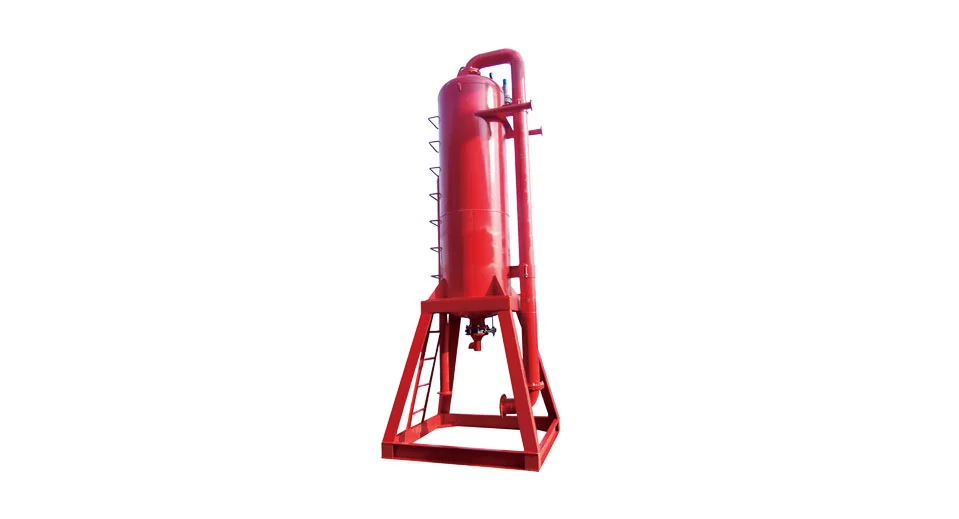In the drilling industry, managing escaping gases from the drilling fluid (or mud) is crucial for operational safety and efficiency. This is where the mud gas separator (MGS) comes into play. Widely known as a gas buster, the mud gas separator is a critical piece of safety equipment in the oil and gas industry and solid control companies. This article will dive deep into its work principles, design, sizing calculations, and the distinct features and benefits it provides.

The primary function of a mud gas separator is to remove gas from the drilling mud. When drilling fluid returns to the surface, it can contain entrained gas. This gas must be safely separated and vented to prevent hazardous situations. Let's explore the fundamental principles that guide the operation of this solids control equipment equipment.
Inlet Phase: Drilling fluid carrying entrained gas enters the mud gas separator through an inlet at the top of the vessel.
Impact and Separation: Upon entrance, the fluid strikes a series of baffles—a set of weighted or angled plates. Here, the kinetic energy of the gas-liquid mixture decreases, promoting the separation of gas from the fluid. The gas has lower density and rises to the top, while the heavier liquid falls to the bottom.
Vapor Outlet: The separated gas rises and exits through a vent or flaring stack, which safely disposes of it.
Liquid Outlet: The degassed drilling fluid collects at the bottom of the separator and is redirected back into the active mud system through an outlet valve, maintaining a continuous loop.
The effectiveness of a mud gas separator heavily depends on its design, which takes into account factors like mud flow rate, gas volume, and operational pressures. Let's break down the key components that define its design.
Baffles and Impact Plates
Baffles and impact plates play a critical role in enhancing gas separation by allowing maximum contact between the gas and liquid phases. They reduce the velocity of the incoming mixture, aiding the gas to rise and separate efficiently.
Vent Line
The vent line's primary function is to expel the separated gas. It must be designed to handle various gas volumes and pressures, ensuring safe venting. Some vent lines may also incorporate flaring systems to burn off residual gases safely.
Liquid Drain Outlet
This outlet is designed to return the degassed mud to the mud tanks. Its diameter and placement are crucial for maintaining the fluid's flow dynamics, ensuring minimal backpressure and efficient recirculation.
Pressure Vessel
The vessel's material and construction should adhere to relevant pressure ratings and safety standards. Commonly made of robust steel alloys, these vessels must withstand high internal pressures and corrosive environments.
Sizing a mud gas separator involves complex calculations to ensure it can handle the required volumes without experiencing faults. Several factors come into play:
Flow Rate of Mud: The volume of drilling mud passing through the separator per unit of time, often calculated in gallons per minute (gpm) or liters per second (L/s).
Gas Volume/Flow Rate: The anticipated volume of gas that needs to be separated. This is usually determined through historical data or specific drilling conditions.
Operational Pressure: The pressure at which the separator must operate. This includes both the pressure of the incoming fluid and the internal pressure allowable for the vessel.
Example Calculation
Suppose we are working with the following conditions:
- Mud flow rate = 1000 gpm
- Gas production rate = 1 million standard cubic feet per day (scfd)
Using these values, we can employ standardized formulas or software solutions to derive the necessary dimensions and volume capacities for the separator. Typically, experts use empirical relationships derived from field data to fine-tune their designs.
A well-designed mud gas separator offers numerous features and benefits that enhance both safety and efficiency in drilling operations.
Safety
By effectively separating hazardous gases from the drilling fluid, MGS reduces the risk of blowouts, fires, and explosions. It ensures that operations can proceed without endangering workers or equipment.
Operational Efficiency
An efficient separator ensures that the degassed mud is promptly returned to the active mud system, minimizing delays and maintaining optimal drilling conditions.
Cost-Effectiveness
Although requiring an initial investment, a good MGS can save considerable costs in the long run by preventing expensive blowouts and minimizing downtime.
Robust Construction
Modern mud gas separators are built to withstand harsh drilling conditions, boasting durable materials that resist corrosion and can endure high pressures.
Versatility
These separators are adaptable to various drilling conditions and can handle a wide range of gas and mud flow rates, making them suitable for diverse drilling operations.
Reduced Environmental Impact
By safely venting the separated gases, MGS helps in complying with environmental regulations and reduces the ecological footprint of drilling operations.
Mud gas separation is a cornerstone of safe and efficient drilling. The mud gas separator by BZ mud gas separator factory, through its intricate processes, designs, and practical advantages, ensures that drilling operations can proceed smoothly while safeguarding both human and environmental well-being. Understanding the principles, design elements, and necessary sizing calculations helps in optimizing the effectiveness of these crucial safety devices. Thus, whether you’re involved in planning, designing, or implementing drilling projects, knowing the ins and outs of mud gas separators is indispensable for achieving operational excellence.